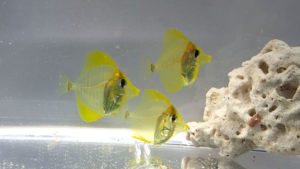The very first success for my project came with collection #3. The egg collectors were set on March 16, 2016. Eggs were harvested the morning of March 17, 2016. There were a total of 20,800 eggs with 11,648 viable (56%). The eggs were stocked at a fairly high density of 58.24/mL into a single 200L flow-through tank. The average rearing parameters for this egg collection was: 2R6.2 ± 1˚C and 30.0 ± 0.8 ppt. DO was maintained ≥ 6.0 mg/L, and pH ranged from 7.8 – 8.0. Despite a somewhat low viability, there was a substantial hatch. I checked on the larvae each day, and at three days post hatch, I prepared to administer first feeding as well as background algae. The larvae were extremely tiny and it was hard to distinguish between species at such an early age. I added the first feeding of copepod nauplii, and I did not observe many larvae feeding. I figured this was due to relatively cool water temperature, which was approximately 25ºC at the time. These larvae developed very slowly, and many died off within the first 5 to 10 days post hatch. Upon examining the larvae, all appeared to have fully developed eyes and mouths; however, many did not have full guts. I wasn’t exactly sure why some of them were not eating, but I continued to feed and monitor accordingly. The water quality checked out fine.



I was able to take a few good pictures at 25 days post hatch. The post-flexion larvae at approximately 6.13mm looked good. Very well developed eyes and mouth, and completely developed guts full of food. Dorsal spines were forming, and there was an increased amount of pigmentation, with a slight deepening of the body. Perhaps the most important observation was that the larvae had already entered their tholichthys stage of development, with bony plates forming around the head extending back towards the posterior end of the larvae.
Many of the larvae continued to drop for no apparent reason. The larvae at 40 days post hatch were 7.02 millimeters long, had substantial deepening of the body, and distinct dorsal and ventral spines. Fins were fairly well developed, and the gut was still appeared full of food. The larvae fed on nauplii, enriched rotifers, and newly hatched artemia. The bony plates, characteristic of the tholichthys stage were thicker and more prominent. This “helmet” was clearly visible on the heads of the larvae. Some of the larvae were also beginning to exhibit a silvery appearance. The larvae continued to dwindle down to only a few. By day 60, there was a single lone survivor. There were a few scares with this larvae, particularly when it was nowhere to be found and was thought to be lost (quite a story). However, it pushed through, and settled at approximately 74 days post hatch. For fear of losing this special larva, I held off on taking any photos until I knew it completed settlement. By 88 days post hatch, it was clear the mystery Chaetodontid was the milletseed butterflyfish, Chaetodon miliaris. Its juvenile coloration is seen in the above photo.
It was quite the journey, but this lone survivor was the first of its kind to be reared in captivity, and it too was cute at the about the size of a dime. It had quite the personality and loved being in front of the camera!



